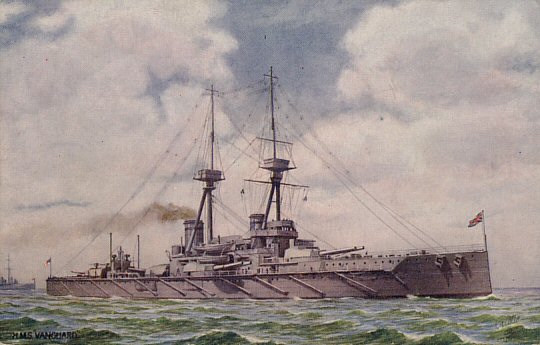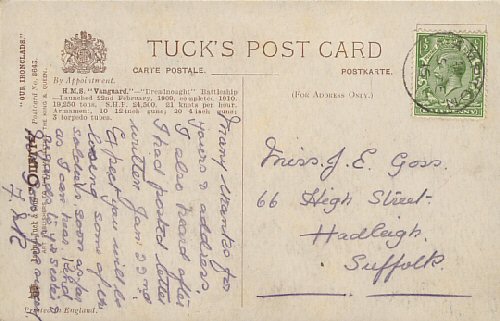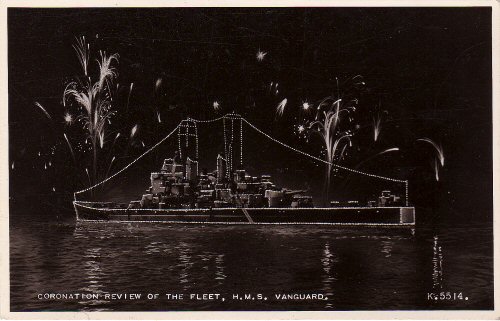
Exploded 7 July 1917
Built Devonport Dockyard, laid down April 1908, completed March 1910, cost £1,606,030.
Size:
Length 531 feet waterline 536 feet overall, 84 feet 1 inch beam, draught 28 feet 11 inches load, displacement 19,700 tons load 22,800 tons deep.
Propulsion:
4 shaft Parsons turbines, 24,500 shp, 21kts.
Trials:
Vanguard 25,780 shp = 22.3 knots.
Armour:
10-7in belt, 9-5in barbettes, 11in turret faces, 3-0.75in decks
Armament:
10 x 12in 50cal MK XI (5 x 2), 20 x 4in (20 x 1), 4 x 3 pounder (4 x 1), 3 x 18in TT
1st Battle Squadron The Grand Fleet.
1 September 1914 fired on on a false alarm submarine at Scapa Flow.
April 1916 transferred to 4th Battle Squadron.
The Battle of Jutland. Fired 80 12in rounds, received no damage.
7 July 1917 accidentally exploded at Scapa Flow with the loss of 804 crew.
The Vanguard was the victim of an internal explosion. Her magazine was detonated by unstable cordite and within seconds the battleship was annihilated together with all but three of her 800 crew and officers. One of her 12 inch turrets was thrown over a mile to land in Flotta. This appalling accident happened in July 1917. In some ways it resembled the explosion that the cruiser HMS Natal suffered in Cromaty Firth in 1915, and for some time sabotage was suspected.
She was built at Barrow and completed in 1910. She was one of the earlier descendants of the original Dreadnought and was a powerful warship to start with. HMS Vanguard displaced nearly 20000 tons and was 536 feet long. Her armament was substantial. It included 5 gun turrets each with two 12 inch guns, twelve 4 inch guns and three 18 inch torpedo tubes. Her turbines were powerful. She spent much of her time in WW1 at Scapa Flow, with the odd sortie across the North Sea. She saw action at Jutland, but came out without damage.
The Vanguard - or what's left of her - lies in 34 metres just north of Flotta. In the 1960's and 70's some salvage was carried out on her, but since 1982 she was declared a war grave. It is expressly forbidden to dive within 100 metres of her. Apparently, there is much wreckage, live ammunition, capstans and so forth that are littering the sea bed. The bows still stand intact and are the final resting place of some of those 800 people who perished with her.

